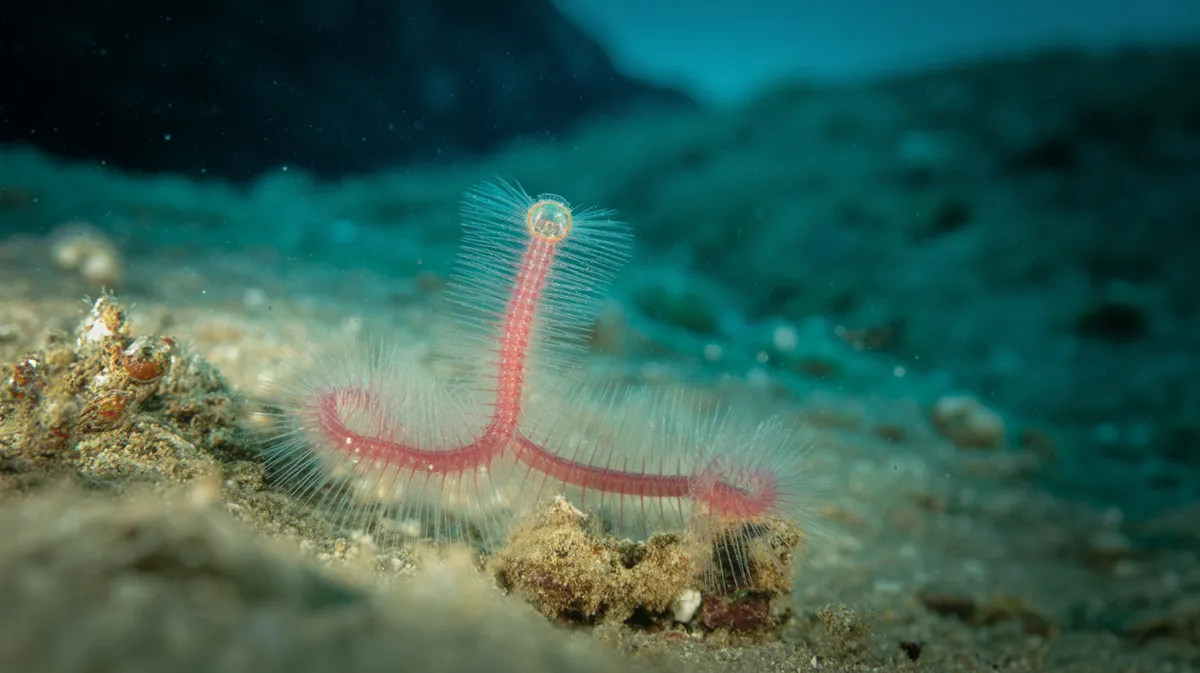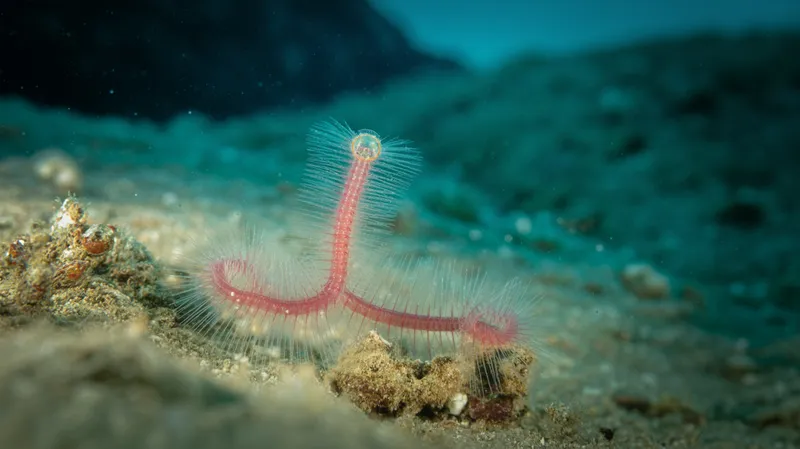
Gossamer Worm
Tomopteris helgolandica

Meet the Gossamer Worm
The Gossamer Worm is a delicate and transparent marine polychaete worm found in the open ocean. Its ribbon-like body is almost entirely see-through, with graceful lateral appendages that enable it to glide effortlessly through the water. This worm is bioluminescent, producing a striking yellow light when disturbed, which is rare among marine invertebrates. Gossamer Worms are adapted to life in the midwater zones, where they prey on smaller zooplankton using their agile bodies and bristle-like parapodia.
Classification
Invertebrate
Habitat
Open ocean (pelagic zone)
Diet
Carnivore
Lifespan
1-2 years
Conservation
Least Concern
Weight
0.2-0.5 grams
📖Fascinating Facts
Bioluminescent Glow
When disturbed, Gossamer Worms can produce a bright yellow light, a rare color for marine bioluminescence.
Midwater Drifters
They inhabit the open ocean's midwater zone, rarely coming close to the surface or the sea floor.
Almost Invisible
Their transparent bodies help them avoid predators by blending almost seamlessly into their watery surroundings.
📋Detailed Description
Tomopteris helgolandica, commonly known as the Gossamer Worm, is a pelagic polychaete annelid renowned for its ethereal transparency and delicate, ribbon-like morphology. Adult individuals typically range from 2 to 6 centimeters in length, with a laterally compressed, elongated body composed of numerous segments, each bearing a pair of broad, paddle-shaped parapodia. These parapodia are fringed with setae (bristles) and are highly muscularized, allowing for agile, undulating swimming motions that facilitate both rapid escape and precise maneuvering in the midwater column. The worm's body is almost entirely transparent, rendering it nearly invisible in its open-ocean habitat and providing effective camouflage against predators. The head is equipped with a pair of small antennae and simple eyes (ocelli) that detect changes in light intensity. Tomopteris helgolandica is notable for its unique bioluminescence: when disturbed, it secretes a yellow, water-soluble luminescent compound from specialized glands in the parapodia, a rare trait among marine invertebrates, as most produce blue or green light. This bioluminescence is believed to function as a defensive mechanism, startling predators or serving as a decoy. The species is holoplanktonic, spending its entire life cycle in the pelagic zone, and is adapted to a wide range of depths, typically from the epipelagic to upper mesopelagic zones (approximately 0–500 meters). Its internal anatomy is specialized for a planktonic lifestyle, with a reduced coelom and a highly developed musculature for sustained swimming. Tomopteris helgolandica is solitary and displays little evidence of social behavior, with individuals dispersing widely in the open ocean.
💡 Did you know?
The unique yellow glow of the Gossamer Worm has fascinated marine biologists, as most oceanic bioluminescent creatures produce blue or green light.
🔬Research & Sources
🎭Behavior & Social Structure
Tomopteris helgolandica is an active, free-swimming predator that primarily hunts at night, exhibiting diel vertical migration to exploit prey-rich surface waters under the cover of darkness. It uses its sensitive antennae and photoreceptive ocelli to detect prey and navigate the dimly lit pelagic environment. The worm preys on a variety of smaller zooplankton, including copepods, chaetognaths, and larval crustaceans, capturing them with rapid, darting movements and grasping them with its eversible pharynx. Feeding is typically solitary, and there is no evidence of cooperative hunting or aggregation. When threatened, the worm can rapidly undulate its body to escape, and may release a burst of yellow bioluminescent fluid from its parapodia to distract or confuse predators. Tomopteris helgolandica is generally considered to be a solitary species, with minimal direct interaction between individuals outside of reproductive events.
👶Reproduction & Life Cycle
Reproduction in Tomopteris helgolandica is sexual and involves external fertilization. The species is gonochoristic, with separate male and female individuals. During spawning, which is believed to be triggered by environmental cues such as temperature and food availability, both sexes release gametes into the surrounding water column. Fertilization occurs externally, and the resulting embryos develop into planktonic trochophore larvae, which are fully adapted to the pelagic lifestyle from an early stage. There is no parental care; larvae are independent upon hatching and undergo several molts before reaching adult form. Breeding is thought to occur year-round in temperate waters, with possible peaks in spring and early summer when planktonic food is most abundant.
🛡️Adaptations & Survival
Tomopteris helgolandica exhibits a suite of adaptations for pelagic life. Its transparent body and internal organs minimize visibility to both predators and prey, while the flattened, wing-like parapodia provide efficient propulsion and maneuverability in the water column. The species' unique yellow bioluminescence is an evolutionary specialization, likely serving as a defensive mechanism by startling predators or acting as a sacrificial lure. The worm's musculature is highly developed for continuous swimming, and its reduced coelom decreases body density, aiding in neutral buoyancy. Sensory adaptations include simple eyes for detecting light gradients and antennae for tactile and chemical sensing. The eversible pharynx allows for rapid prey capture in the open water.
📚Research Sources
🎨Cultural Significance
Tomopteris helgolandica has minimal direct cultural significance to humans, as it is rarely encountered except by marine biologists and oceanographers. However, its striking bioluminescence and delicate appearance have made it a subject of fascination in scientific literature and marine documentaries, often used to illustrate the diversity and wonder of midwater life. Its unique yellow bioluminescence has also been referenced in studies of marine light production and has inspired interest in bioluminescent mechanisms for potential biomedical and technological applications.
🔬Recent Research & Discoveries
Recent research on Tomopteris helgolandica has focused on the chemical nature and ecological function of its yellow bioluminescence, which is produced by a water-soluble luciferin-luciferase system distinct from those found in most other marine organisms. Studies have also investigated the biomechanics of its swimming, revealing highly efficient undulatory propulsion enabled by the structure and muscular control of its parapodia. Molecular phylogenetic work has clarified its placement within the Tomopteridae family and provided insights into the evolutionary origins of pelagic polychaetes. Ongoing research includes the impact of environmental changes on its distribution and the potential use of its bioluminescent compounds in bioengineering.
🎥Wildlife Videos

The Wonderful World of Deep Sea Worms
Polychaete worms in the deep sea are among the most diverse organisms in the ocean. From giant tube worms and Pompeii ...
Natural World Facts

Microworlds: Plankton 101
The watery world of phytoplankton and zooplankton is a daily drama—an ocean teeming with plants and animals. It's the ocean ...
Hakai Institute

Insects of Ghana part 1 50P
December 2013 made the Danish expedition visits to several of Ghana's rainforests to registers butterflies, during these visits, ...
Henrik Bloch

Unveiling the Mysterious World of Ocean Worms
There are thousands of species of worms in the worlds oceans. Some tiny, some more than eight feet long. Some of them feed on ...
The WoW Factor

Nature's Illuminating Survival Tactics
Bioluminescence is the production and emission of light by living organisms. In some species it is produced by symbiotic bacteria ...
The WoW Factor

100 Plus Breathtaking Sea Creatures You've Never Seen | 8k Ultra HD Marine Life Documentary
Description:100 Breathtaking Sea Creatures You've Never Seen | 8k Ultra HD Marine Life Documentary In this peaceful ...
PB DOCUMENTARY
🌍Habitat Information
The Gossamer Worm typically inhabits Open ocean (pelagic zone) environments. Gossamer Worms have adapted to their environments with specialized features and behaviors.
Primary Habitat:
Open ocean (pelagic zone)
More detailed habitat information will be available soon.
🛡️Conservation Status
The Gossamer Worm is currently classified as Least Concern. Conservation efforts are crucial for preserving this species for future generations.
Common Threats:
- 🏠Habitat loss and fragmentation
- 🌡️Climate change impacts
- 🎯Hunting and poaching
- 🏭Human-wildlife conflict
⚠️Threats & Conservation Challenges
Currently, Tomopteris helgolandica faces few direct threats due to its wide distribution and pelagic lifestyle. However, like many oceanic planktonic organisms, it may be indirectly affected by large-scale environmental changes such as ocean warming, acidification, and shifts in planktonic food webs driven by climate change. Pollution, particularly microplastics, poses a potential risk, as ingestion could impact feeding and health. There is no evidence of targeted human exploitation, and the species is not considered threatened; population trends are stable, and it is classified as Least Concern. Nonetheless, ongoing changes in oceanic ecosystems could present future challenges.
🔬Scientific Classification
Scientific Name
Tomopteris helgolandica
Classification Hierarchy
🔍 About Taxonomic Classification
Taxonomic classification is a hierarchical system used by scientists to classify and organize living organisms based on shared characteristics and evolutionary relationships.
The system moves from broad categories (Kingdom) to increasingly specific ones, with each animal's scientific name typically consisting of its Genus and species.
📝Community Notes
Share your observations and insights about the Gossamer Worm with our community of wildlife enthusiasts.
Join Our Community
Sign in to share your observations and connect with fellow wildlife enthusiasts.
Sign In to ContributeNo community notes yet
Be the first to share your observations about the Gossamer Worm!
Explore Gossamer Worm
Select a tab above to learn more about this amazing animal.
📸Photo Gallery
No photos available for this animal yet.
🌟Discover More Wildlife
Continue your journey of discovery with more fascinating animals from our database
